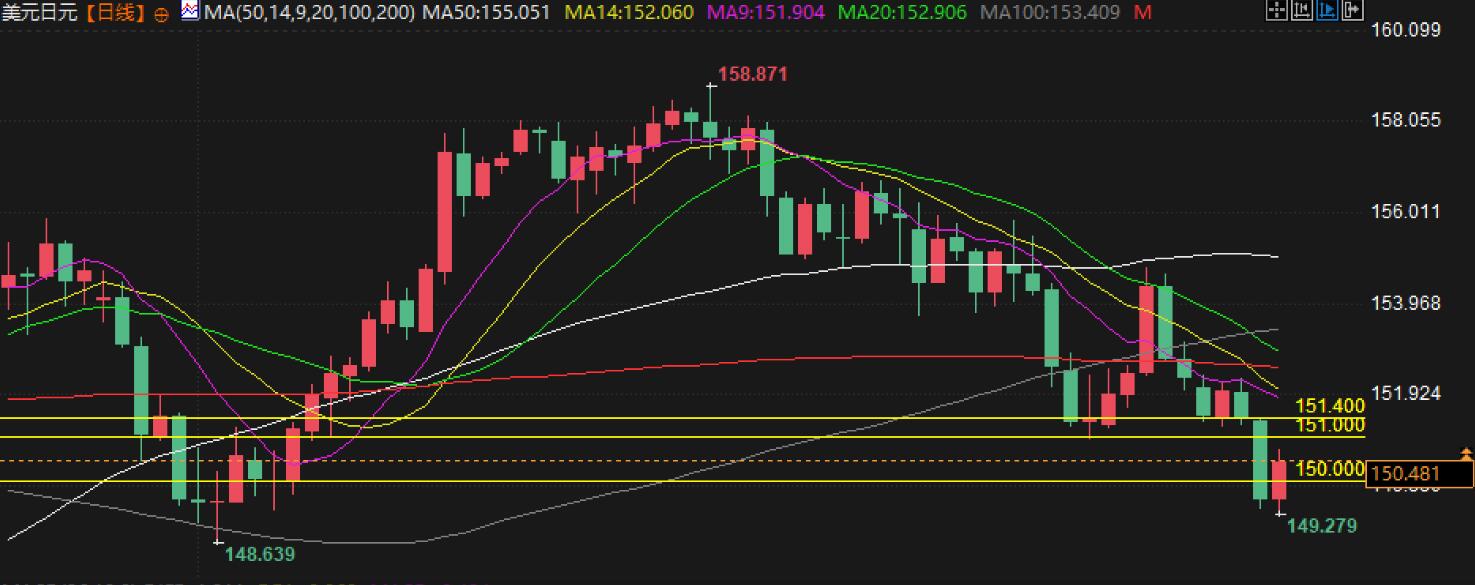Forex Trading Analysis: Is USD/JPY Going Long?
At the beginning of the European market on Friday (February 21), the Japanese yen maintained a slightly pressured trend. The weakness of the Japanese yen is mainly influenced by domestic economic data in Japan, especially the strong growth of the national consumer price index (CPI), which has driven up the yield of Japanese government bonds (JGB). This phenomenon has exacerbated the interest rate differential between Japan and other countries, putting pressure on the low yielding yen.
At the same time, comments from Japanese Finance Minister Katsuyuki Kato and Bank of Japan Governor Kazuo Ueda have intensified speculation in the market that the Japanese government may intervene in the bond market. These factors have increased the pressure on the yen and helped the US dollar/yen achieve a significant rebound from the low point in the 149.30-149.25 range this Friday. Next, the market will pay attention to the release of global PMI data and speeches from members of the Federal Open Market Committee (FOMC) in the United States, which may have an impact on the US dollar.
Fundamental analysis
The performance of the Japanese economy and the monetary policy of the Bank of Japan are the core driving factors behind the trend of the Japanese yen. The recently released national CPI data in Japan shows that inflation continues to remain high, which supports the upward trend in Japanese government bond yields. On the one hand, this is due to the upward trend of global interest rates, and on the other hand, it also reflects the signs of Japan's domestic economy gradually getting rid of its long-term deflationary predicament. Although inflationary pressures are rising, the Bank of Japan's current monetary policy remains loose and there are no clear measures to raise interest rates, putting the yen at a disadvantage in terms of interest rate differentials compared to other high interest rate countries.
However, market expectations for the possibility of the Bank of Japan raising interest rates in the future are gradually increasing. Combined with comments from Japanese government officials, it has sparked speculation about intervention in the bond market. If the Bank of Japan takes measures to curb the rise in bond yields, it will provide short-term support for the yen, but in the long run, the yen still faces significant interest rate differential pressure. The outlook for the US economy and the monetary policy of the Federal Reserve will continue to dominate the trend of the US dollar/Japanese yen in the short term.
From a geopolitical perspective, despite the uncertainty facing the global economy, the performance of the US economy and the tightening monetary policy of the Federal Reserve still provide support for the US dollar, thereby driving up the US dollar/Japanese yen exchange rate.
Technical analyst interpretation:
Support and resistance level analysis
At present, 150.00 has become the immediate support level for USD/JPY. If the price falls below this level, it may further fall back to the area of 149.30-149.25, which is a recent multi month low. If further down, 149.00 will become the next key support level, and falling below this area may test the lowest point of 148.65 in December 2024.

The pressure level above is mainly concentrated around 151.00, which is an important technical resistance level in the short term. If the price breaks through this level, it may attract more bulls to replenish, pushing the price to continue rising to 151.40, or even close to 152.00. If the price further rises, the 152.65 line will become a stronger technical resistance level, especially near the 200 day simple moving average (SMA). If this important technical level is breached, it may change the recent trend towards bulls.
Moving Average Analysis
From the short-term to medium-term moving average, the price of USD/JPY has fallen below the range of 151.00-150.90, indicating a clear bearish trend. The current price is below the 50 day and 100 day moving averages, indicating significant pressure from bears, and the exchange rate may face strong selling pressure at the 151.00 level.
Technical indicator analysis
On the daily chart, the MACD indicator shows a clear bearish trend, with the DIFF and DEA lines consistently in negative areas, and the bar chart is green, indicating that the market's selling pressure remains strong. RSI (14 cycles) is also in the negative zone, and there is still room for oversold, indicating that the selling power in the market still dominates. Therefore, technically speaking, there is a significant downside risk for the US dollar/Japanese yen, and prices may continue to be under pressure in the short term.
Volatility analysis
At present, there is significant market volatility, with the US dollar/Japanese yen fluctuating sharply around important technical levels. Although there is a certain chance of rebound, the overall market sentiment remains cautious, and price fluctuations may continue to remain significant.
Trend prediction
The US dollar/Japanese yen still faces downward pressure in the short term, and if it breaks through the support level of 150.00, it may further decline to the 149.30-149.25 range. If the price rebounds to the 151.00 line, it may face strong selling pressure. The market may experience a certain technological rebound, but the space for this rebound may be limited, and the possibility of breaking through 152.65 is low.
conclusion
Overall, the technical aspect of USD/JPY shows a strong bearish trend, and the price may further test the 149.30-149.25 range downwards. Although there may be a certain rebound in the short term, the overall trend tends to be downward. Pay attention to the technical breakthroughs at 150.00 and 151.00.
Tips:This page came from Internet, which is not standing for FXCUE opinions of this website.
Statement:Contact us if the content violates the law or your rights
